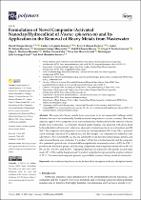Formulation of Novel Composite (Activated Nanoclay/Hydrocolloid of Nostoc sphaericum) and Its Application in the Removal of Heavy Metals from Wastewater
Fecha
2022Autor(es)
Choque Quispe, David
Ligarda Samanez, Carlos A.
Ramos Pacheco, Betsy S.
Solano Reynoso, Aydeé M.
Quispe Marcatoma, Justiniano
Choque Quispe, Yudith
Peralta Guevara, Diego E.
Martínez Huamá, Edgar Luis
Correa Cuba, Odilon
Masco Arriola, Mery Luz
Lechuga Canal, Washington
Montalvo Amanca, Fred
Metadatos
Mostrar el registro completo del ítemResumen
The removal of heavy metals from wastewater is an environmental challenge which
demands the use of environmentally friendly materials that promote a circular economy. This study
aimed to apply a novel composite of an activated nanoclay/hydrocolloid in the removal of heavy
metals from wastewater. A composite blended under pressure was prepared with spray-dried
hydrocolloid derived from Nostoc sphaericum algae and activated nanoclay in an acid medium and 1M
NaCl. The composite and components were analyzed through infrared (IR), X-ray (XR), ζ potential,
cation exchange capacity (CEC), particle size, and SEM images. The composite was subjected to the
adsorption of heavy metals (Pb, As, Zn, and Cd) at pH 4.5 and the removal percentage, kinetics, and
adsorption isotherms were evaluated. It was observed that the activated nanoclay and the composite
that presented a particle size of around 400 nm significantly increased (p-value < 0.05) the CEC, ζ
potential, the functional groups, and chelating components, removing heavy metals above 99% for
Pb, As 33%, Cd 15%, and Zn 10%. Adsorption kinetics was adjusted to the pseudo second-order
model (R
2 > 0.98), and the Langmuir and Freundlich models better represented the sorption isotherm
at 20 ◦C. The formulated composite presents a good ability to remove heavy metals in wastewater
Colecciones
El ítem tiene asociados los siguientes ficheros de licencia:

